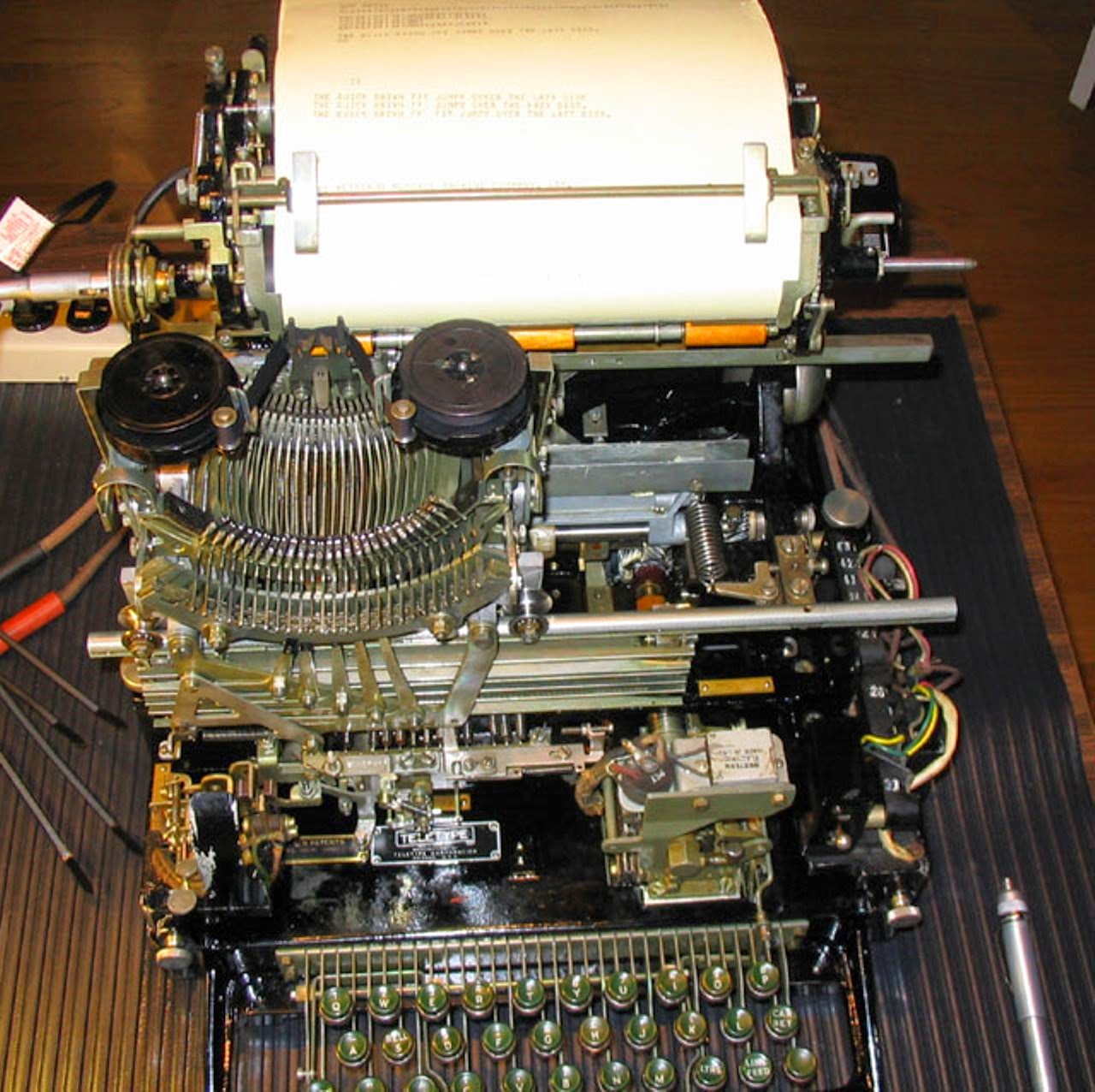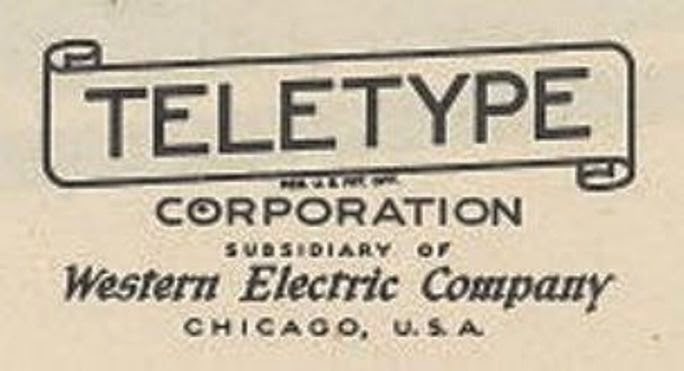It was easier, at first, to show the model we didn't use, rather than that which we did use.
Using pictures from the DCS Tape Relay at Phu Lam, Vietnam, helped explain the Army's teletype machinery used during the Vietnam War.
To see this posting, click HERE.
This post is long, but may be worth your time. Click HERE
As for the Model 15 teletype, we'll start with a little history. With the invention of Morse Code, companies around the world began working on models in which entire words could be transmitted at once over a line.
In Europe, the Creed Company in Great Britain and Siemens in Germany began patenting methods of word transmission.
In the United States, Morkrum Company and Kleinschmidt Electric Company were neck-and-neck in the development of machines that were very much alike.
Rather than compete, the two companies merged in the 1924-25 years to form the Morkrum-Kleinschmidt Corporation. Below is a picture of the Morkrum founders.
Photo from SamHallas.co.uk/repository
In 1928-29, the name of the company was changed to Teletype Corporation. All owners seemed satisfied with the new company, as patents for improvements and changes were making the Model 15 a breadwinner.
Several plants in the Chicago area produced the Model 15 and its components. Later on, two huge plants were built after Teletype Corporation was purchased, and Edward Kleinschmidt created Kleinschmidt Laboratories.
 |
| From 3dmojo.com |
The above machine is the Model 15 KSR (keyboard send and receive) which was a virtual monopoly in the United States.
To see the long explanation of the picture above, click HERE |
| Photo from aetheltd.com
This is the Model 15 which had seen better years. It was decided to refurbish it which was no easy undertaking.
|
 |
| Photo from aetheltd.com
Here is the refurbished Model 15. Of all the parts to be replaced, the most difficult to find were the green coverings for the keyboard. It has been said that this machine, the KSR 15, had more parts than a Ferrari.
So, the Model 15 KSR was just that, initially. A person on one end would type and that message would be printed out on a Model 15 KSR at the other end. And so it went. No tape was involved in the process yet. We are talking about 1925-29. Eventually, the Model 15 was connected to an incoming cable and was able to act solely as a printer. It did a lot more than what is typed here and as the post progresses, you will see just how versatile the machine was. Maybe some You Tube clips will show you. The rugged, dependable, and loud Model 15 can be seen and heard HERE |
Photo from aetheltd.com
The Model 15 became the workhorse of the Teletype Corporation. Between 1930 and 1963, some 200,000 were sold, mainly to the military.
Before WWII, the Model 14 punched paper tape reperforator was being produced and around 60,000 were sold by 1956.
We were fortunate to find this user's manual
 | ||||||||
| Photo from Teletype Corporation |
Here are the specifics on the KSR Model 15
 |
| Photo from circuitousroot.com
This is a keyboard for the Model 15 which is another quick indicator of the machine that built Teletype Corporation's reputation.
There were only 3 rolls of keys, with all the letters in upper case on the middle row.
For numbers, the shift key plus any of the keys on the top row produced a digit. The shift key and the middle row produced symbols and in the bottom row were more symbols and punctuation.
In the 1960s, this basic configuration is what we learned to type on in signal school, although the keys themselves had changed shape and color.
There is a forum group today called "Green Keys" in which those interested in radio and telecommunications get together. To see their page, click HERE.
|
 |
| Photo from baudot.net |
 |
| Photo from budot.net
The Model 14 printing reperforator was the next step after the Model 15. The Model 14 could be used to type, print, and perforate the tape all at one time.
Connected to an incoming message cable, the keys were not needed as the machine would print and perforate the tape automatically.
To see this in action, just click here.
|
.jpg) |
| Photo from baudot.net
So, logically, we have a Model 14 Transmitter-Distributor (Reader) which transmits the punched tape message to someplace, with a paper copy to a Model 15 KSR.
This gives us everything we need to prepare and send a perforated paper tape message. To see it in action just click here.
Put all three of these devices together in 1941 and we have what was called, of course, the Model 19. In came a printed page and tape from somewhere in the world.
Out went messages on tape with a printed copy on the KSR Model 15. Sure makes sense to me. |
 |
| Photo from baudot.net |
With all of the additions to the teletype stable of machines, none had as great an impact as the Model 15 RO (receive only) printer.
Not only did the military eat these up, but news services such as UPI, AP, and Western Union had a method of receiving messages from many sources. To see one of these in action ClICK HERE
 |
| Photos from baudot.net |

| Photo from circuitousroot.com |
 |
| Photo from circuitousroot.com |
 |
| Photo from circuitousroot.com |
 |
| Photo from circuitousroot.com |
 |
| Photo from circuitousroot.com |
 |
| Photo from circuitousroot.com |
By the end of 1929, the company decided to change its name to Teletype Corporation. Shortly after this, the Great Depression began and the entire world changed.
 |
| Photos from circuitousroot.com |
 |
| Photo from circuitousroot.com |
We have had this Smith-Corona typewriter since the early 1960s. It works as well now as it did when it was new. They should last forever, or at least, our lifetimes!
In 1956, SCM, Smith-Corona-Marchant, the typewriter and calculator company, bought Kleinschmidt Labs and its new factory which had been built in 1949 in Deerfield, IL.
This is one of the new logos for the Teletype Corporation which, in 1960, moved into a huge plant it had built in Skokie, IL.
The double-T was the indicator on the logo that this was a new company. It meant Edward Kleinschmidt was no longer part of Teletype Corporation.
This is another logo of the Teletype Corporation. Think Model 28 and beyond into the 1980s.
 |
| Photo from Teletype Corporation |
This ruler is an anniversary of something, but the dates don't provide any particular event in 1907.
 |
| Photo from navy-radio.com |
In 1942, the first of some 27,000 women were allowed to serve in the Navy. The original name given to them, and which still stands today, was WAVES.
WAVES stood for "Women Accepted for Volunteer Emergency Service." In 1948 women were allowed to become actual members of the Navy.
Here they are shown serving as teletype operators. The idea was to have WAVES serve in clerical occupations.
Did any of you guys in the Army or Air Force know that WAVES is an acronym? Not me.
 |
| Photo from navy-radio.com This was one of the few pictures to be found of the Navy using the complete Model 19 from Teletype Corporation. |
 |
| Photo from circuitousroot.com.
This must have been in the very early days of the Model 15.
|
 |
| Photo from militarymuseum.org
This has to be a prized photograph of teletypes in action.
|
 |
| Photo from spotlights.fold3.com
Shown here are two women with security clearances working on teletypes during WWII. They were members of the WAACS.
|
In 1951, the Model 28 was being produced by the Teletype Corporation. It was supposed to replace the Model 19,
But, in realty, the Model 15 and all of its necessary components were used for one more war.
Several photos taken during the Korean and shortly thereafter were just found.
Again, all respects are due to the soldiers who were in the Army Signal Corps during "The Forgotten War."
The
Model 15KSR has a reel full of tape for reperforating. The
transmitter-distributor seems attached to the teletypewriter.
This young man seems to be taking a message directly from a tape reperforator for sending to a specific station.
This is a tape relay station, it appears. Sending and receiving is proceeding on both sides of the room.
Here we have a color picture of a Model 15 teletypewriter and a Model 14 typing reperforator. The transmitter looks to be on the left side of the teletype.
When you think of Korea, sometimes the thoughts are of how cold it could be. Here we have a unit sending and receiving inside these trucks.
This "tape ape" is running this punched tape relay station by himself.
Even the teletype repair guys were inside the truck out in the fields.
Several photos taken during the Korean and shortly thereafter were just found.
Again, all respects are due to the soldiers who were in the Army Signal Corps during "The Forgotten War."
 |
| Photo from Truman Library.org |
| There couldn't have been a better picture of the latest version of the Model 19 than this. |
Photo from TrumanLibrary.org
This young man seems to be taking a message directly from a tape reperforator for sending to a specific station.
Photo from TrumanLibrary.org
This is a tape relay station, it appears. Sending and receiving is proceeding on both sides of the room.
 | ||||
| Photo from rattrig.com |
Here we have a color picture of a Model 15 teletypewriter and a Model 14 typing reperforator. The transmitter looks to be on the left side of the teletype.
Photo from rattirg.com
When you think of Korea, sometimes the thoughts are of how cold it could be. Here we have a unit sending and receiving inside these trucks.
 |
| Photo from rattirg.com |
This "tape ape" is running this punched tape relay station by himself.
Photo from rattrig.com
Even the teletype repair guys were inside the truck out in the fields.
Photo from Korean War Memorial, Washington, D.C.
There were over 33,000 soldiers killed from 1950-53. Over 4,000 others were missing in action.
Coupled with this, the number of dead and missing was matched by those wounded in this war which ended with an armistice at the 38th parallel.























I am looking for someone who could print out a short message on a Teletype Model 15 for a museum display at our headquarters in Illinois, USA. Thanks!
ReplyDeleteGreat Post - My father was a teletype repair person in the signal corps during the Koran War. Thanks for sharing,
ReplyDeleteIt was a very important MOS and know the pride he took in his work. Glad to hear from you.
ReplyDeleteI just found 2 of these machines in my grandpa's old garage.
ReplyDelete